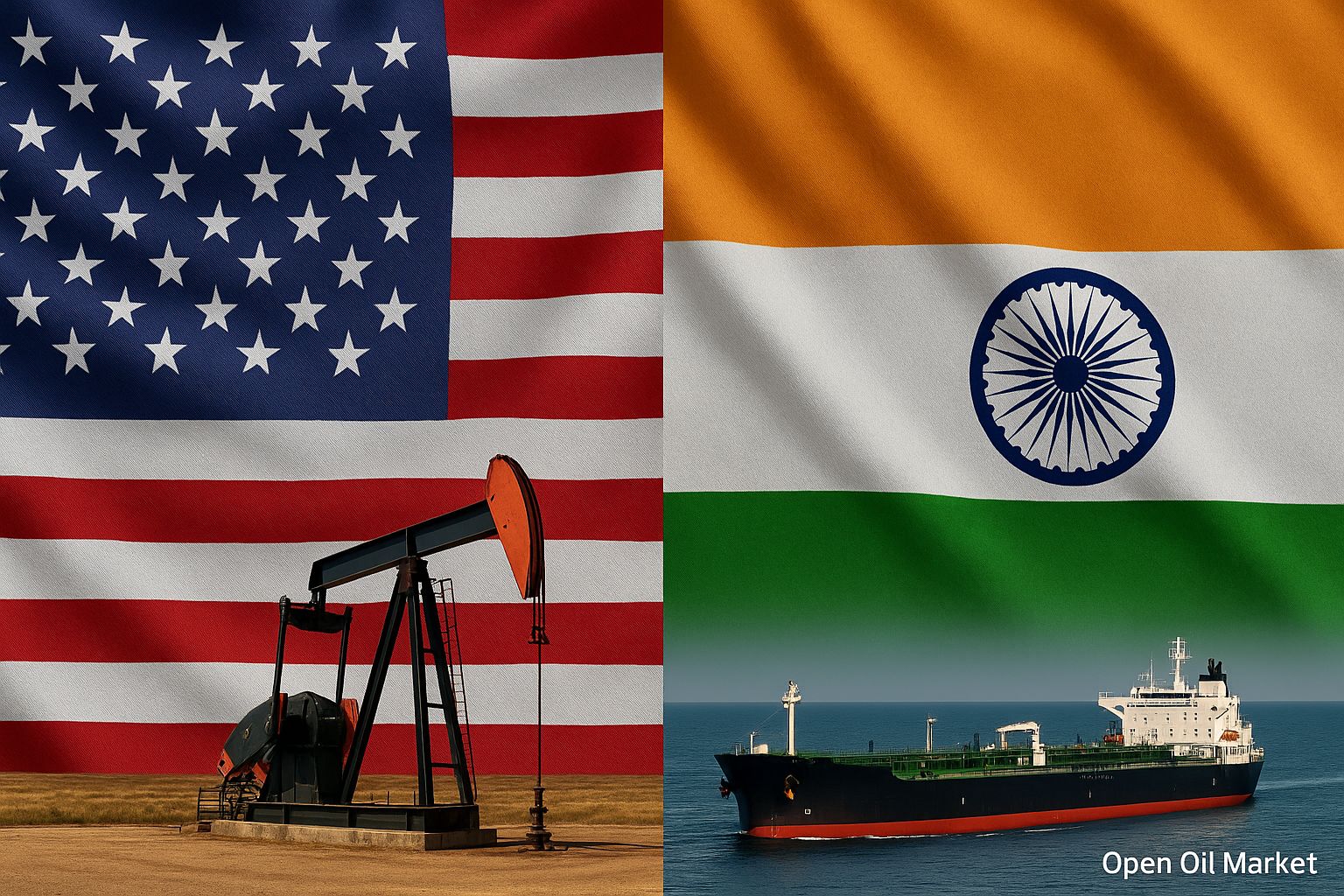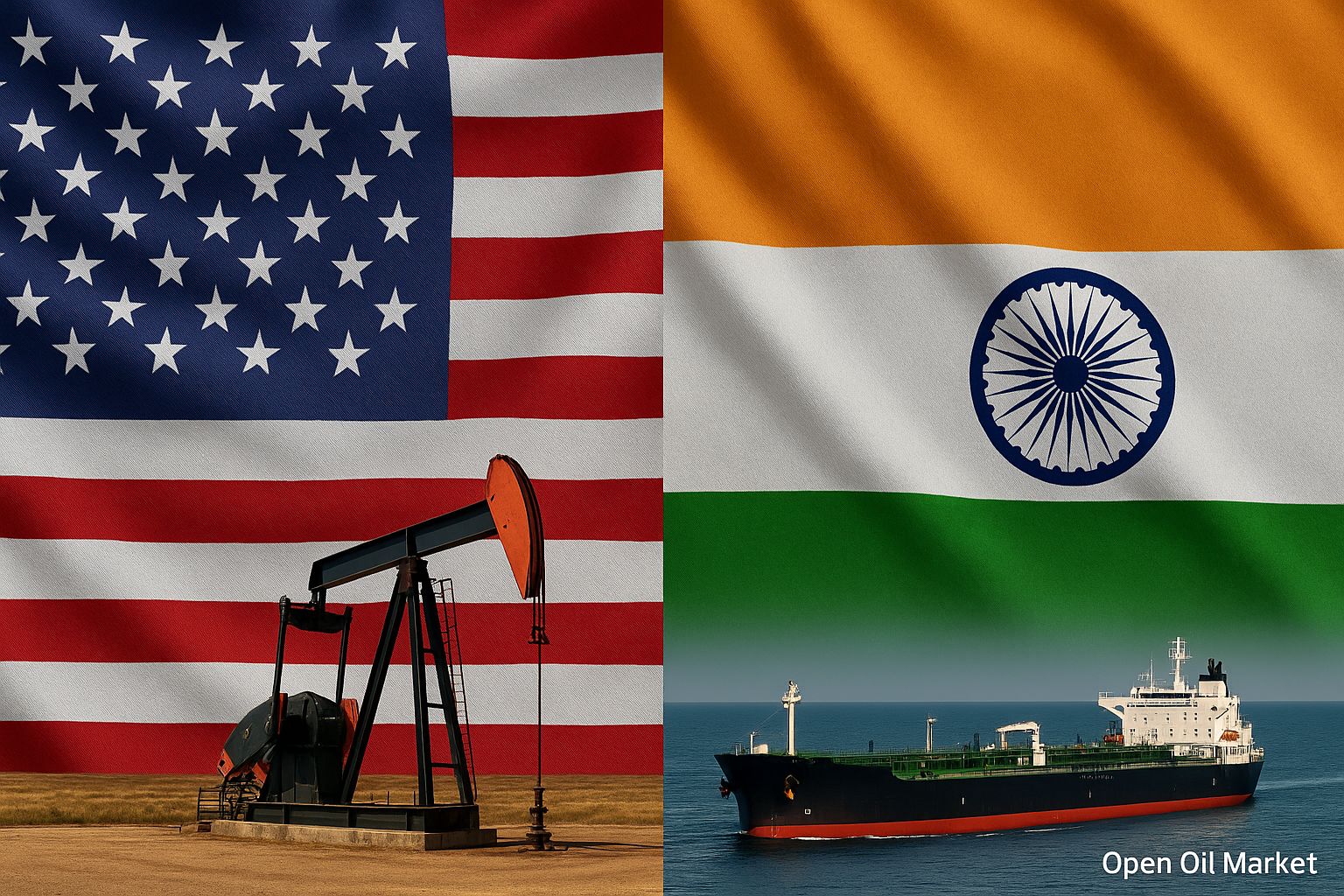
Key Energy Sector News as of August 7, 2025: The U.S. Intensifies Pressure on India for Trading with Russia, Export of Petroleum Products from the RF Restricted, Oil Prices Stabilize. A Detailed Review for Energy Market Participants.
The current events in the fuel and energy complex (TEC) as of August 7, 2025, are once again in the spotlight for investors and market participants. Washington is ramping up its sanction pressure on the largest buyers of Russian oil, particularly with new trade tariffs imposed on India, escalating geopolitical tensions. Against this backdrop, global oil prices have ceased their decline and are demonstrating relative stabilization as investors assess OPEC+ actions and the risks of secondary sanctions. Russia continues to implement stringent restrictions on the export of petroleum products to support the domestic fuel market. Concurrently, Europe is accelerating its gas reserves ahead of winter, while the global energy sector is witnessing a revival in demand for traditional energy resources, such as coal, amid high prices and the need for reliable energy supply. Below are the details of these and other key news from the raw materials and energy sectors.
Washington Doubles Tariffs for India on Russian Oil Trade
The United States has sharply intensified pressure on India, the second-largest global market for Russian oil. On August 6, President Donald Trump signed an order imposing additional 25% import duties on goods from India, justifying this move by New Delhi's continued purchases of energy from Russia. These new tariffs are added on top of existing ones, resulting in a total U.S. tariff rate for Indian exports being doubled from 25% to 50%. According to the document, the increase will take effect in 21 days. Previously, Trump threatened "three-digit" tariffs (100% or more) against countries purchasing Russian oil if Moscow does not halt hostilities in Ukraine by August 8 — the date Washington has designated as a deadline. While specific figures for the new sanctions were not publicly clarified, the current move to double the tariff sends a strong message to markets and trade partners.
The justification for the sanctions highlights that India is not only continuing to import significant volumes of Russian oil but is also reselling part of these purchases in the open market for profit. Washington regards such operations as undermining efforts to isolate Russia. The White House has also indicated that similar trade restrictions could threaten other countries actively purchasing hydrocarbons from the RF. Concurrently, the U.S. signals readiness for further tightening of sanctions post-August 8 if its demands are not met. This amplifies uncertainty in the global oil market, prompting companies to reconsider supply chains in light of potential new barriers.
New Delhi Prepares a Response and Points Out Western Double Standards
India has resolutely reacted to the trade pressure from the U.S. The Indian government has made it clear that it does not intend to curtail imports of Russian oil, viewing them as essential for its energy security. The Indian Ministry of External Affairs publicly stated that purchases from Russia are driven by forced circumstances: traditional suppliers to India from the Middle East redirected major volumes of oil to the European market post the onset of the Ukrainian crisis, leaving New Delhi with the necessity to seek alternatives. Furthermore, Indian officials emphasized that those very Western nations condemning India continue to collaborate with Russia across various domains. Such actions have been labeled as manifestations of "double standards."
- National Interests Above All: India asserts that its priority is to ensure affordable energy prices for its population and economy. Purchasing Russian oil helps curb fuel price increases in the domestic market.
- The West Trades with the RF: In New Delhi's reminder, EU countries still import gas, petrochemicals, fertilizers, and other resources from Russia, while the U.S. continues to procure certain categories of Russian goods (such as nuclear materials). This undermines the demand for a complete cessation of trade with the RF.
- Unjust Criticism: According to officials, Washington's grievances are unfounded, particularly considering that Western partners had previously encouraged Indian purchases from Russia to stabilize the global oil market.
In response to the sanctions, India is contemplating a set of actions. Officials hint at potential retaliatory tariffs on American goods, as well as enhanced cooperation with alternative oil suppliers, such as countries in the Middle East or Latin America, to reduce dependency on the U.S. market. Additionally, media reports reveal that against the backdrop of Trump's threats, a high-level delegation has been sent to Moscow: National Security Advisor Ajit Doval has arrived for negotiations with the RF leadership. Although the visit was planned in advance, given the current context, it has acquired particular significance for coordinating energy policy between India and Russia. The Kremlin, on its part, has labeled Washington's attempts to force third countries to cease cooperation with Russia as illegal.
Oil Market: Prices Recover Amid Sanction Risks
After several days of decline, global oil prices have ceased their downward trajectory and partially recovered. On August 6, prices for the benchmark Brent variety rose back to around $68–69 per barrel, while the American WTI variety increased to approximately $66. The price increase of about 1% over a day occurred amidst a combination of factors. Firstly, the U.S. Department of Energy reported an unexpected reduction in crude oil inventories by 3 million barrels over the past week, indicating stable demand and supporting the market. Secondly, investors are evaluating potential supply disruptions due to escalating sanctions: paradoxically, news about the tariffs imposed by Trump against India have pushed prices higher, as the market anticipates possible redistribution of oil flows and additional supply risks.
However, the price increase remains tempered. One reason is the actions of OPEC+, which have already been accounted for in prices. The alliance of oil-producing countries previously agreed to increase oil production starting in September, and these additional volumes are moderately cooling the market. Concerns regarding a slowdown in the global economy and weak demand dynamics in China are also preventing prices from surging sharply. Several analytical agencies have already revised their forecasts, expecting the average price of Brent in the fourth quarter of 2025 to hover around $60–65 per barrel. Nevertheless, most experts believe that a deep price collapse will not occur: as critical low levels approach, OPEC+ countries may once again curtail supply to support the market.
OPEC+ Increases Oil Production Cautiously
OPEC+ member countries continue to adhere to a policy of gradual oil production increases. In early August, eight key participants in the agreement (including Saudi Arabia, Russia, UAE, Kuwait, and others) announced an increase in the cumulative production quota by 547 thousand barrels per day starting in September. This decision means the early cessation of voluntary production cuts implemented at the end of 2023, when the coalition had voluntarily limited production by 2.2 million b/d. Now, thanks to monthly increases from April to August and the scheduled step in September, the coalition will be able to fully abandon these additional restrictions over a year ahead of the initial plan.
The market reacted relatively calmly to the news of the production increase. The OPEC+ decision was anticipated and already factored into price expectations, thus it did not cause significant disruptions. Moreover, the increase in quotas occurs against a backdrop of geopolitical tension, which softens the effect on prices. Experts note that it is important for OPEC+ countries to regain market shares lost during the period of restrictions without allowing prices to collapse. Allies are closely monitoring the situation: the issue of further steps will be discussed at the OPEC+ monitoring committee meeting on September 7, where the fate of the remaining voluntary cuts of 1.65 million b/d (which have been extended until the end of 2026) will be reviewed. In the meantime, the alliance presents a united front, aiming for a gradual supply increase in response to recovering demand.
Expert Commentary: “In this regard, the threat of new tariffs against India and China is a good informational reason for further increases in quotas,” noted Sergey Tereshkin in an interview with Forbes.
Russian Market for Petroleum Products: Exported Banned, Prices and Budget Under Control
The internal fuel market in Russia continues to enforce a complete ban on the export of certain petroleum products, primarily automotive gasoline. The government previously extended the restrictions to all producers and traders: from the end of July until August 31, 2025, the export of gasoline from the country is prohibited. This emergency measure aims to saturate the domestic market and curb price increases at gas stations. According to the Moscow Fuel Association, the average retail price of AI-92 gasoline in Moscow reached around 59 rubles per liter at the beginning of August, while AI-95 was about 65 rubles/l, which is noticeably above the levels seen at the start of the year. Despite the export ban, fuel prices at gas stations are gradually increasing, although the rate of growth has slowed compared to peaks in June.
To stabilize the situation, the government is also utilizing budgetary mechanisms. In particular, oil refineries (refineries) are receiving compensations under the damping mechanism—subsidies that mitigate the difference between high world prices and fixed domestic fuel prices. In July, the volume of damping payments rose to a record ~60 billion rubles, helping curb the price increase of gasoline for end consumers. However, such expenditures are burdening the federal budget. According to the Ministry of Finance, oil and gas revenues to the Russian treasury in July amounted to about 787 billion rubles—below the planned level and the third consecutive month lower than expectations. The government is discussing the possibility of temporarily adjusting or suspending the damping mechanism if oil prices and exchange-related factors continue to reduce export revenues. Thus, balancing interests—keeping prices affordable for the population and ensuring budget revenues—remains a complex task for authorities and market participants.
Gas Sector: Europe is Storing Reserves and Restructuring Routes
The European gas market is entering the end of summer with confident figures on reserves. Underground gas storage (UGS) in the EU is over 72% full of total capacity as of early August, significantly surpassing average levels from previous years for the same date. EU countries are actively injecting gas, aiming to achieve a target fill level of ~90% by November 1. The high reserve level and a steady influx of liquefied natural gas (LNG) from the U.S., Qatar, and other exporters are contributing to relative price stability in Europe: current exchange prices remain significantly below the peaks of 2022–2023.
The energy geography of gas supplies to Europe has changed significantly over the last year. Here are the key changes in routes and sources:
- Ceasing Transit through Ukraine: From January 2025, all supplies of Russian pipeline gas through the Ukrainian gas transportation system have been completely halted after the expiration of the contract between Gazprom and Naftogaz.
- Southern Corridor – Main Channel: The only currently functioning route of Russian gas to the EU remains the "Turkish Stream" pipeline and its extension to Southern Europe (via Turkey and the Balkans). Approximately 50 million cubic meters per day are transmitted through it, partially compensating for the lost volume from northern routes.
- Northern Pipes Inoperative: The "Nord Stream" pipeline has been rendered inoperative following the 2022 sabotage, while the "Yamal–Europe" pipeline ceased to be used due to sanction-related disagreements between Russia and the West.
- Record LNG Supplies: The share of liquefied gas in EU imports has risen to an all-time high. LNG reception terminals in European countries are operating at high capacity, allowing them to replace lost pipelines' gas volumes.
- Local Solutions: In Russia, Gazprom is optimizing domestic logistics: for instance, after brief pauses, gas supplies to the Kaliningrad region have resumed via Lithuania, and in case of disruptions, a floating LNG terminal is employed. Although these technical maneuvers do not directly affect Europe, they emphasize adaptation to the new constraints.
Thanks to the diversification of sources and accumulation of reserves, Europe is approaching the autumn-winter period more prepared than a year ago. However, potential risks remain—from weather factors (a cold winter might sharply increase demand) to competition with Asia for LNG cargoes. Regulators and gas companies in the EU remain vigilant, continuing efforts to increase reserves and develop infrastructure for gas reception and distribution. Overall, the current situation in the European gas market inspires cautious optimism: the threat of fuel shortages has been pushed back, although it is still too early to relax.
Coal Energy: Price Increase and the Return of Traditional Fuel
The global energy sector is noting a remarkable trend: after several years of decline, demand for coal is rising once again. Prices for thermal coal in the Asian market have been climbing for the third consecutive month. In July, the average price of Australian coal reached ~$113 per ton—the highest since the beginning of the year—while South African coal traded around $94 per ton. The price increase is fueled by steady demand from power plants in countries like China, India, and Vietnam, where economic growth requires reliable energy sources. Despite global decarbonization goals, many states find themselves compelled in the short term to increase coal burning to ensure stable electricity generation.
The United States is experiencing a genuine "coal renaissance." In the first five months of 2025, electricity generation at coal-fired power plants in the U.S. increased by about 19% compared to the same period in 2024. According to the Energy Information Administration (EIA), around 25% of all electricity in the country is now generated from coal—the highest share in several years. This surge is driven by multiple factors:
- High Gas Prices: The rise in natural gas prices has made coal a more economically attractive fuel for generation, especially for baseload capacities.
- Reliability of the Energy System: In an effort to avoid interruptions, authorities and companies maintain coal plants on standby to compensate for the insufficient stability of renewable energy sources.
- Political Support: The Trump administration has rolled back various environmental restrictions and encourages the extraction of fossil fuels, including coal, as part of its drive for energy independence. This has provided fossil fuel sectors with a further impetus for development.
Experts emphasize that while the development of renewable energies (wind, solar, etc.) continues to accelerate, a complete immediate shift away from traditional fuels is not feasible. The International Energy Agency predicts that global electricity generation from coal will begin to gradually decline post-2025. However, the current situation demonstrates the complexity of navigating a transition period in energy systems worldwide without leveraging older resources. For investors, this signals that the oil and gas sector, alongside coal, will retain significance in the coming years—provided that modernization and environmental improvements in production take place.
For Energy Sector Investors
Collectively, the news from Thursday reflects the complex and multifaceted landscape of the global TEC. Geopolitical moves—such as U.S. sanction pressure on Russian energy buyers—bring new risks and provoke a restructuring of trade flows. Simultaneously, market mechanisms continue to act: OPEC+ balances supply increases against demand, and consumers and businesses adapt to changing conditions, whether through seeking alternative suppliers or substituting energy sources. In traditional sectors (oil, gas, coal), a temporary strengthening of positions is observed due to high prices and the need for energy supply stability, even amid a strategic shift toward a "green" transition. Energy sector investors and companies in Russia and worldwide continue to closely monitor these trends to make timely strategic decisions. The combination of flexibility and foresight in such an environment becomes a cornerstone of success for market participants—from oil and gas corporations and refineries to the electricity sector and renewables.




